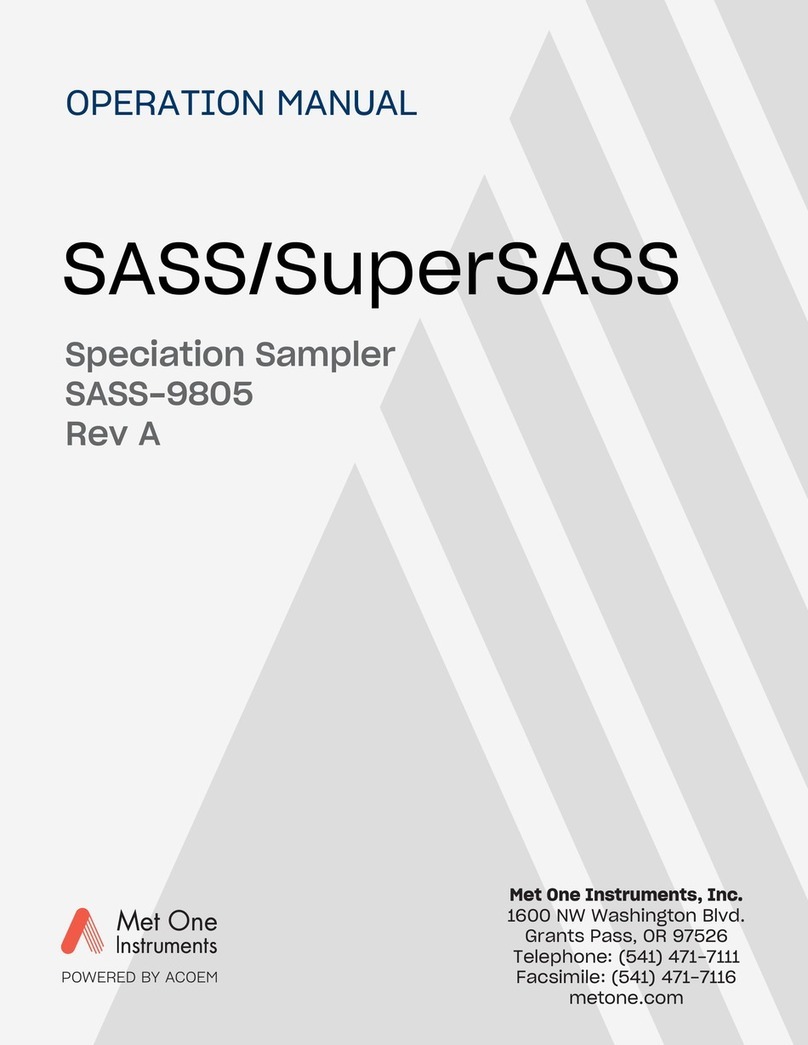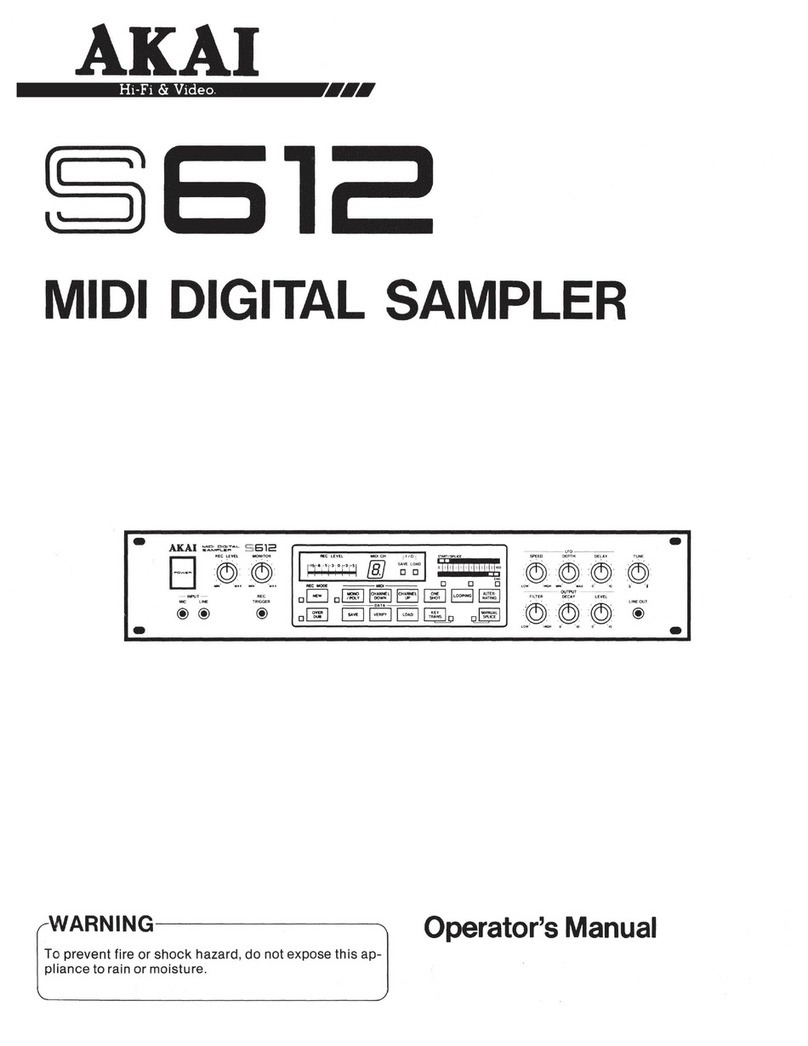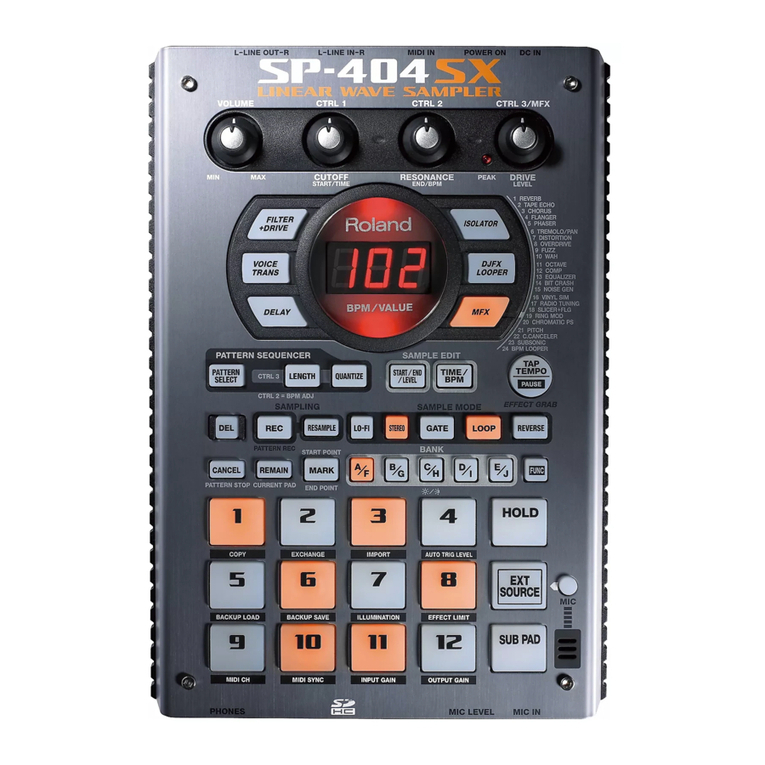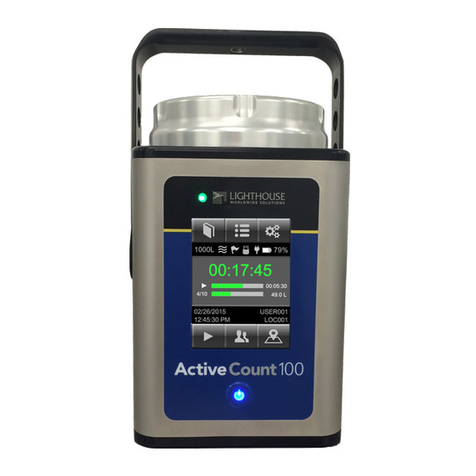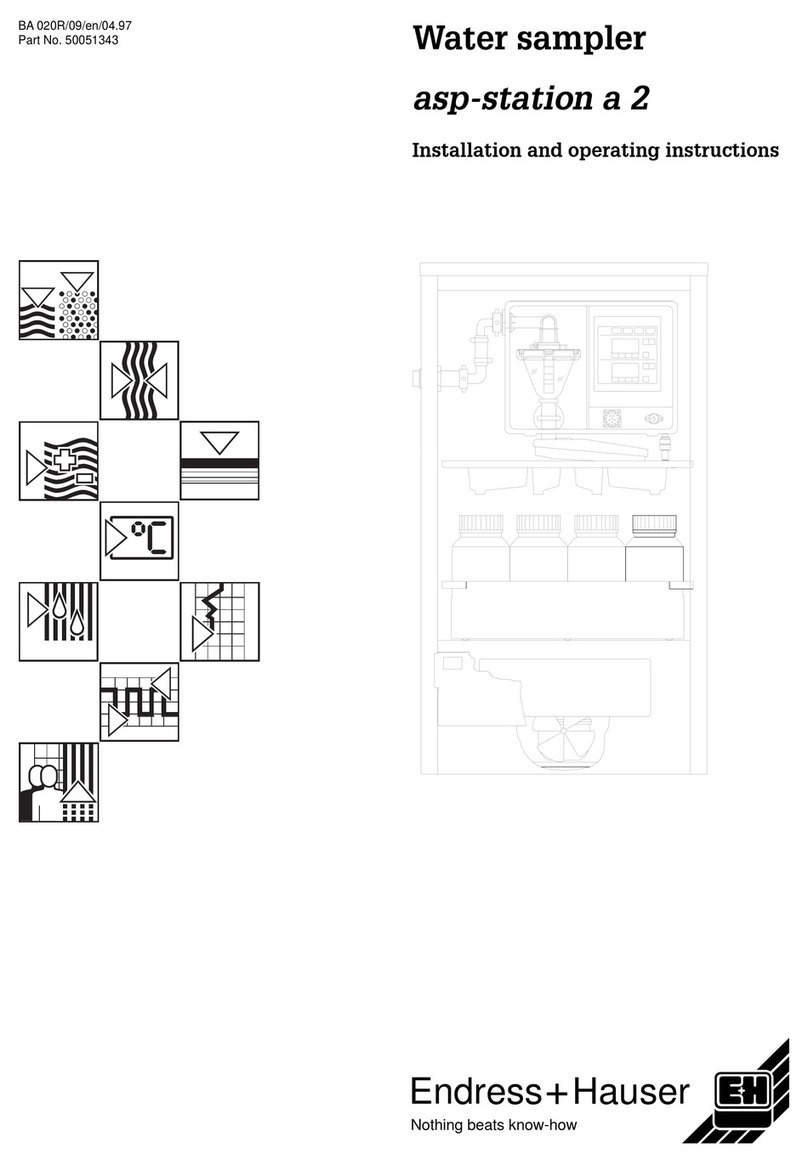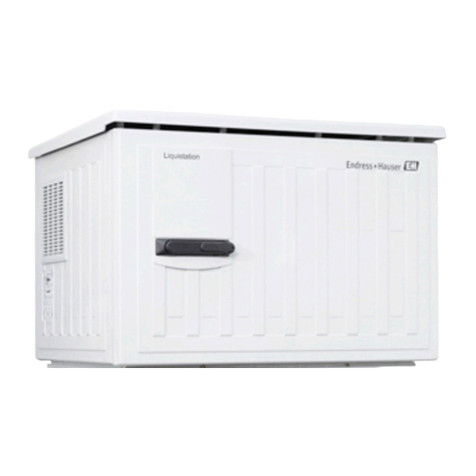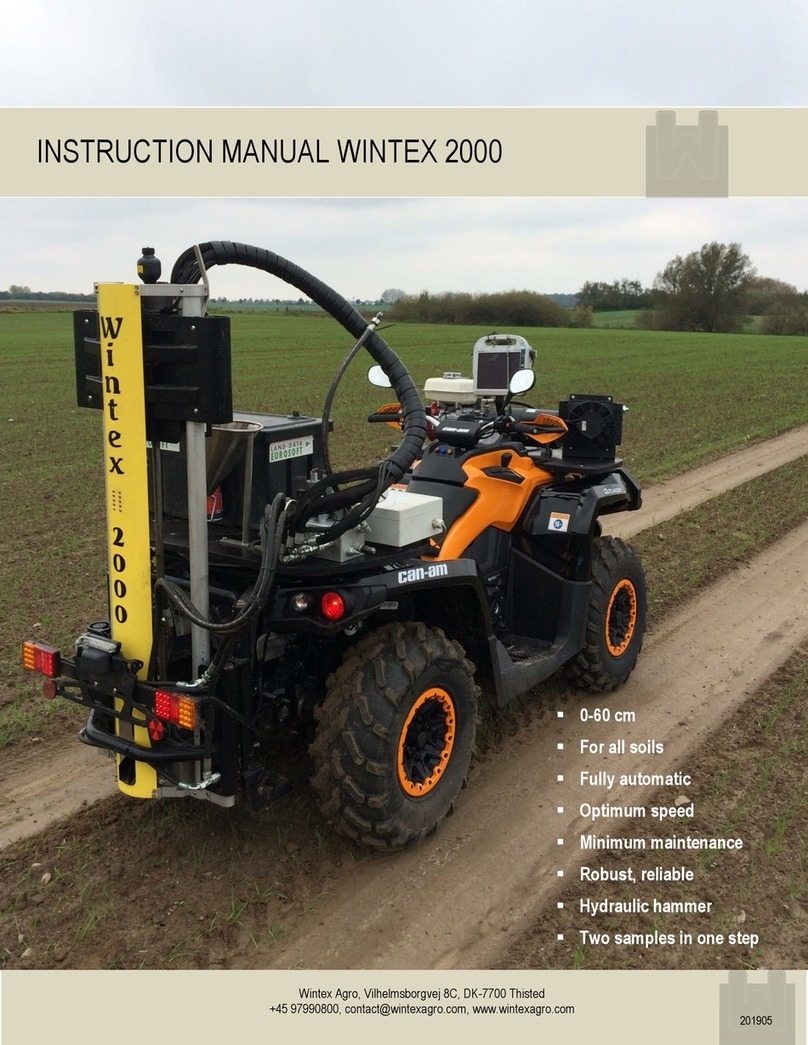ARA Instruments LFR-6 User manual

ARA LFR-6 Sampler
Operation Manual
January 18, 2022

TABLE OF CONTENTS
SECTION PAGE
1. INTRODUCTION 1
1.1. Principles of Operation 2
1.2. Particulate Matter Sampling 2
2. HARDWARE DESCRIPTION 3
2.1. PM 10 Inlet 3
2.2. PM 2.5 Cyclone 3
2.3. Filter Holder 3
2.4. Flow Control System 3
3. INITIAL SETUP 4
3.1. Basic Assembly 4
3.2. Deployment 5
3.3. Power Source 6
3.3.1.Batteries 6
3.3.2.AC Power Supply 7
3.3.3.Using Batteries and AC Power Supply 7
3.3.4. Solar Panel Supply 7
3.4. Powering LFR-6 Sampler On/Off 7
3.5. Navigation 7
3.6. Sleep Mode 7
3.7. Setting Time and Date 7
3.8. Installing a Filter 8
4. OPERATIONAL OVERVIEW 9
4.1. Home Screen 9
4.2. Operational Modes 9
4.2.1.Mode: Off 9
4.2.2.Mode: On 9
4.2.3.Mode: Met 9
4.2.4.Mode: Program 9
4.2.5.Mode: Sector 9
4.2.6.Mode: Remote 9
4.3. Data 10
4.4. Setup 10

SECTION PAGE
5. OPERATING THE LFR-6 SAMPLER 12
5.1. User-Defined Programming 12
5.1.1.Creating a Program to Operate at a Specific Time 12
5.1.2.Running a Program 12
5.1.3.Ending a Program 13
5.2. Meteorological Functions 13
5.2.1.Sector Mode (Directional Sampling) 13
5.2.2.Start a Sector Run 13
5.3. Real-Time Particulate (RTP) Profiler 14
5.3.1. Accuracy 14
5.3.2. Calibrating the RTP Profiler 14
5.4. View Summaries 15
5.5. Export Data 15
6. MAINTENANCE 17
6.1. Servicing Schedule 17
6.2. Service Water Trap 17
6.3. Clean PM10 Inlet, PM2.5 Cyclone, and Filter Holder 17
6.3.1.Cleaning PM2.5 Cyclone 18
6.3.2.Cleaning PM10 Inlet 19
6.3.3.Cleaning Filter Holder 20
6.4. Clean RTP Profiler Filter 21
6.5. Replace O-Rings 21
6.6. Pump Rebuild 21
6.7. Leak Check 22
7. CALIBRATION 22
8. TROUBLESHOOTING 23
9. WARRANTY POLICY 24
10. PARTS LIST 25
APPENDIX A: Calibration Using an ARA FTS Flow Calibrator 28
QUALITY CONTROL FORM 31

ARA Instruments LFR-6 Sampler Manual
1
1 INTRODUCTION
ARA Instruments Mission
Our mission at ARA Instruments is to help environmental professionals make important air quality
decisions by providing them with cost effective, accurate, and reliable instrumentation. Our air samplers
and calibration instruments are used in outdoor ambient air quality applications as well as indoor and
industrial uses.
Overview
In response to the need for a low cost alternative to traditional site-based particulate monitors, ARA
Instruments has introduced the Low-Flow Research 6 LPM Sampler (LFR-6). It integrates with many
additional components for unmatched versatility. The compact sampler collects 24-hour TSP, PM10, or
PM2.5 filter samples and can simultaneously measure local meteorological parameters. It can also be
equipped with a Real-Time Particulate (RTP) Profiler to log temporal particulate variations. For added
versatility, the LFR-6 Sampler can be operated in directional wind sampling mode or meteorological
mode.
The LFR-6 Sampler maintains accuracy, while costing a fraction of traditional site-based air samplers. Its
compact size and battery-powered function, gives the LFR-6 Sampler many advantages over traditional
air samplers. Deployment and relocation is quick and easy, and allows monitoring in locations that are
inaccessible with traditional air samplers. Flexible mounting options allow for stand–alone support or
the use of existing poles and structures. The ability of the LFR-6 to operate on rechargeable batteries
also significantly reduces the cost of establishing a monitoring site.
The LFR-6 Sampler is designed for easy operation and maintenance. The intuitive user interface makes
programming and calibrating the sampler simple. PM10 and PM2.5 inlets are field serviceable and
require only monthly cleanings. Filter holders accept standard 47mm FRM cassettes for easy handling of
various filter media. Batteries can be recharged in approximately 1-hour. Data log files with 5-min
averages for all sensors can easily be downloaded to a USB Flash drive.
Cities and governments are deploying networks of LFR-6 Samplers to survey unmonitored areas and
validate permanent Reference Method equipment. Researchers and consultants use the LFR-6 Sampler
in air quality studies and environmental impact assessments. They are also utilized in industrial pollution
applications, such as mines and quarries, and in large construction projects for fence line and roadside
monitoring. The small and quiet LFR-6 Sampler is also a great tool for indoor and industrial workplace
sampling that requires high accuracy.
The LFR-6 Sampler was designed to be the most versatile and cost-effective solution for air pollution
research applications. Traditional filter based sampling methods provide an accurate measurement of
particulate matter at a fixed location over a 24-hour period, and are used to determine compliance with
national air quality standards. However, adding real-time meteorological and PM data gives air quality
professionals a higher understanding of the data, which is crucial to designing effective control
strategies. The LFR-6 Sampler has the capability of directional air sampling for fence line, roadside, or
single source impact air quality investigations. Additionally, the LFR-6 can be used to “saturate” a study
area with multiple samplers to obtain an accurate picture of spatial particulate distribution.

ARA Instruments LFR-6 Sampler Manual
2
1.1 Principles of Operation
The LFR-6 Sampler is empirically designed to be a more compact version of EPA specifications for PM10
and PM2.5 air sampling at 6 LPM. The LFR-6 Sampler is a microprocessor-controlled portable air
sampler, which can be operated manually or programmed to collect scheduled samples. As specified by
the EPA, all critical air sampling parameters are continuously monitored and logged as time indexed 5-
min averages to validate the sample. These parameters include: flow rate, temperature, barometric
pressure, and accumulated volume. Other sampler related performance parameters are also logged. If
the LFR-6 Sampler is equipped with the Real-Time Particulate (RTP) Profiler and meteorological sensors,
then PM10, PM2.5, wind speed, and wind direction are also included in the data record.
The LFR-6 Sampler can be easily deployed. It can be mounted on a variety of structures using our
universal mounting bracket that can be screwed, clamped, or attached to utility poles, trees, fence
posts, etc. Another option is to use a freestanding tripod.
The LFR-6 Sampler is equipped to operate from either AC or DC power sources. In the DC mode, the
sampler operates from an internal battery pack. A charged battery pack is capable of operating the
sampler for about 30-40 hours. This robust capacity allows the sampler to be used in cold weather and
high altitude applications. A charger is supplied so the batteries can be re-charged in approximately one
hour.
1.2 Particulate Matter Sampling
The LFR-6 Sampler can be set up for TSP, PM10, or PM2.5 particulate sampling by configuring the
sampling inlet components prior to the filter medium. To measure TSP, the omnidirectional Louvered
Inlet is all that is required. For PM10 sampling, an FRM style inertial separator (PM10 Impactor) is
added. To collect PM2.5, the sharp-cut ARA VIS-A Cyclone is attached, which physically selects particles
2.5 microns and below. Common LFR-6 inlet configurations are shown in FIG. 1.
The LFR-6 inertial separators (PM10 Impactor) are designed to operate at a nominal sampling rate of 6
LPM. The LFR-6 Sampler incorporates a microprocessor-based active flow control to maintain the
sampling rate as ambient conditions and filter loading changes. The sampling rate is monitored and
adjusted several times a second and logged at 5-min intervals along with all other important sampling
parameters.
To allow for unattended operation, the LFR-6 Sampler is easily programmed to initiate and stop
sampling. For each sampling event, the LFR-6 Sampler generates a summary of important sampling
parameters such as start and stop times, total sampling volume, and average ambient temperature and
pressure as well as 5-min averages of all ambient and sampler operational parameters. The logged data
file can be easily downloaded to a USB flash drive by the operator. The “csv” (comma separated value )
file can easily be imported into a spreadsheet.

ARA Instruments LFR-6 Sampler Manual
3
2 Hardware Description
2.1 PM10 Inlet
The ARA omnidirectional PM10 Inlet is a compact version of the EPA
prescribed Reference Method Inlet, designed for 6 LPM. It features a
screened inlet, wind deflector, and precision PM10 inertial separator
(impactor) with moisture trap. The PM10 Inlet is designed to operate at 6
LPM. The inlet can be used alone for PM10 sampling or in combination
with the ARA VIS-A sharp-cut vortex inversion separator for PM2.5.
2.2 PM2.5 Cyclone
The ARA VIS-A (Vortex Inversion Separator) is a precision engineered and
compact sharp-cut cyclone fitted to the LFR-6 inlet that physically selects
particles 2.5 microns and below. This ensures precise measurement of
only the PM2.5 size fraction. The PM2.5 separator is designed to operate
at 6 LPM and requires the ARA PM10 omnidirectional inlet to collect
accurate PM2.5 samples.
2.3 Filter Holder
The aluminum filter holder is precisely manufactured for a tight seal
and no contamination of the filter media. The filter holder is
designed to use common EPA specified 47mm cassettes for PM2.5
sampling.
2.4 Flow Control System
The LFR-6 Sampler incorporates a microprocessor-based active flow control to maintain the sampling
rate as ambient conditions and filter loading changes. The sampling rate is monitored and adjusted
several times a second and logged at 5-min intervals along with all other important sampling
parameters. Under normal conditions the active flow control will maintain the sampling well within +/-
2%. If the sampling rate cannot be maintained within +/- 5% a flow error is generated and logged, and if
the error continues for 5-minutes the sampler will shut down.

ARA Instruments LFR-6 Sampler Manual
4
3 Initial Setup
3.1. Basic Assembly
When the LFR-6 Sampler arrives, please check to ensure all parts are accounted for and that no items
were damaged during shipping. Please contact ARA Instruments immediately to report any damaged or
missing parts.
Assemble the inlet for the desired sampling particle size. The configurations for TSP, PM10, and PM2.5
are shown in Figure 1.
Figure 1. PM 2.5, PM 10, and TSP Configurations

ARA Instruments LFR-6 Sampler Manual
5
3.2 Deployment
The LFR-6 Sampler is designed for easy deployment. Most air sampling siting guidelines recommend
samples be taken in the normal breathing zone 3-5 meters above ground. To meet these requirements,
the LFR-6 Sampler can be mounted on a Tripod or affixed to a stationary object like a fence post or
utility pole using the Universal Mount Bracket. Both accessories are available form ARA. The Universal
Mount (Figure 2) and Tripod (Figure 3) are shown to the right.
Figure 2 Figure 3
The LFR-6 is designed for secure mounting on any vertical round tubing support of 1.25 –1.375 inches
in diameter (30-35mm). A clamp screw located inside the sampler secures the LFR-6 to the support.
Using the 3/16” Hex L-Wrench located on the battery holder, tighten the clamp screw to secure.

ARA Instruments LFR-6 Sampler Manual
6
3.3 Power Source
3.3.1 Batteries
Each LFR-6 Sampler is equipped with two 18V/5Ah
DeWalt lithium-ion batteries.
Check Battery Charge
Each battery has a Charge Gauge on the front,
consisting of three green LED lights and a button. Press
and hold the Charge Gauge button. The LED lights will
illuminate designating the level of charge left. See
Figure 4 to determine if your batteries need to be charged. Figure 4. Battery Charge Levels
Charge Batteries
Plug the charger into an appropriate AC outlet. The charger provided by ARA Instruments is
rated for 220VAC. If you prefer a 110VAC charger, we recommended DeWalt DCB105.
Insert the battery into the charger as shown in Figure 5.
The red charging light will blink continuously, indicating
the charging process has started. Batteries should be fully
charged within 1 hour. Completion of the charging cycle is
indicated by the red light remaining ON continuously.
The battery is fully charged and may be used at this time
or left in the charger.
The charger is designed to detect certain problems that
can arise. Problems are indicated by the red charging light
flashing at a fast rate. Try a different battery to determine
if the charger is working properly. If the new battery
charges correctly, then the original battery is defective
and cannot be used.
Please read all of the DeWalt instructions for the batteries and Figure 5. Battery Charger
charger included with your sampler for more details about
charging and storing batteries.
Install Batteries
Insert one charged battery into the LFR-6 Battery Holder. Make sure the batteries are fully
seated and latched to the Battery Holder.
Insert the Battery Holder into the LFR-6 Sampler.

ARA Instruments LFR-6 Sampler Manual
7
3.3.2 AC Power Supply
Each LFR-6 Sampler is also equipped with a 120/240V AC Power Supply to be used when an
outlet is available.
3.3.3 Using Batteries and AC Power Supply
The AC Power Supply does not charge the batteries. The batteries can only be charged with the
included Dewalt Battery Charger.
When both the AC Power Supply and Batteries are connected, the LFR-6 Sampler will run off the
AC Power Supply. If the AC Power Supply is interrupted, the Batteries will take over until AC
Power Supply is restored.
3.3.4 Solar Panel System
The LFR-6 Sampler utilizes a Zamp 24V Solar Panel System.
3.4 Powering LFR-6 Sampler On/Off
Place the Power ON/OFF Rocker switch at the lower right of the front panel of the air sampler in the ON
position. The Sampler will boot up into the Home Screen. The default operational mode is MODE:OFF.
3.5 Navigation
Navigate through the menus by rotating the selector knob to highlight a desired selection. Press the
knob to select. The menu system is intuitive, especially to those with air sampling experience. To exit
any menu, rotate the selector knob to highlight the top item of all menus and select EXIT. MODE: OFF
takes you back to the Home Screen.
3.6 Sleep Mode
The LFR-6 Sampler enters power saving “sleep mode” after a few minutes of no input from the
selector knob. In this mode, the LCD screen is blank. To wake up the LFR-6 Sampler, press and
hold the selector knob for 3-seconds.
3.7 Setting Time and Date
On the Home Screen, confirm that the date and time are accurate. If necessary, follow these steps to set
the correct Time and Date:
•Select SETUP from the Home Screen
•Scroll down, highlight SYSTEM SETUP and select
•Scroll down, highlight DATE/TIME and select
•Scroll down until the Day is highlighted and select
•Rotate the selector knob until the correct date is highlighted and select
•Repeat for Month, Year, Hour, Minute, and Second
•Select DATE/TIME:EXIT
•Select YES to save Date/Time
•Select SYSTEM:EXIT and then SETUP:EXIT to return to Home Screen

ARA Instruments LFR-6 Sampler Manual
8
3.8 Installing a Filter
Note: This procedure should take place in a laboratory or clean area. Contact and handling of all
filter media should be limited to the non-exposed outer edge with smooth tipped forceps (non-
serrated) or plastic tipped forceps. Filter media should never be handled with fingers.
•Unscrew the Filter Holder Top from the Filter Holder Bottom
•Remove Filter Cassette
•Use ARA Cassette Separator to open the cassette. The top and bottom of the Filter Cassette
are machined for a press fit. The Filter Cassette Top has a large beveled interior edge. See
Figure 7 for appropriate use of Cassette Separator.
Warning: Manually prying the cassette apart with fingers can result in the cassette violently
opening, causing damage to filter media or support screen.
Figure 7. Open 47mm Cassette
•With forceps, place a pre-weighed, clean filter media onto the Support Screen in the Filter
Cassette Bottom. Install the Filter Cassette Top, firmly and evenly pressing down to
complete the assembly.
•Place the Filter Cassette into the Filter Holder and reassemble by firmly screwing together
the Filter Holder Top and Filter Holder Bottom.
Note: Cassettes can be handled with fingers. Make sure not to touch filter media.

ARA Instruments LFR-6 Sampler Manual
9
4 Operational Overview
4.1 Home Screen
Once the LFR-6 Sampler is powered ON, the Home
Screen appears. The Home Screen displays the Time,
Temperature, Barometric Pressure, Wind Speed,
Battery Voltage, and Hour Meter (Total Pump
Operating Hours).
There are three menu selections across the top of the
Home Screen: OFF, DATA, SETUP. These are the
Administrative Modes.
4.2 Operational Modes
4.2.1 Mode: OFF
When the LFR-6 Sampler is powered on, Mode: OFF is the default setting.
Select this administrative mode to move between the Operational Modes: OFF, ON, MET,
PROGRAM, SECTOR and REMOTE.
4.2.2 Mode: ON
Select to manually turn the LFR-6 pump ON.
4.2.3 Mode: MET
Select to view and log current meteorological parameters and particle sensor data if the Wind
Sensor and RTP Profiler are installed. In this mode, data logging begins after 5 minutes. The
pump will not run in MET MODE.
4.2.4 Mode: PROGRAM
Select to set the sampler to run at user-defined parameters: time, date, duration, interval, and
flow rate. This mode logs all standard parameters, in addition to real-time particle data and
meteorological data (if installed).
4.2.5 Mode: SECTOR
Select to set the pump to run only when the wind direction is from a user-defined sector. Mode:
SECTOR is only applicable when the Wind Sensor is installed.
4.2.6 Mode: REMOTE
Select this mode to set the sampler to run only when remote jumper connections are shorted.

ARA Instruments LFR-6 Sampler Manual
10
4.3 Data
The DATA administrative mode allows the user to view or erase summaries of the last few sampling
events.
VIEW SUMMARIES –In this selection, the last 10 sampling events are stored and organized by
Start Time. The summary data for each event is viewed by scrolling down the LCD screen. To
change and view other events, scroll and select ST (start time and date). Each press of the
selector knob changes the event data to view.
EXPORT LOG –Scrolling to the bottom of the VIEW SUMMARIES screen and selecting
EXPORT LOG allows the user to export a summary, including 5-minute averages of
sensor data and sampling parameters of the selected event to a USB flash drive.
ERASE ALL SUMMARIES –Selecting this option allows the user to erase all sampling event data.
Note: It is not necessary to erase summaries. The newest sampling event will overwrite the
oldest summary data once the maximum has been reached.
4.4 Setup
The SETUP administrative mode has various options relating to the sampler program and system setup.
SET PROGRAM: Allows the user to set the program for the next sampler run. Instructions that are more
specific can be found in Section 5.1.1.
CLEAR ALL DATA: Will delete all sampler runtime data.
EXPORT SETUP: Using USB drive, the user can download sampler settings.
IMPORT PROGAM: A program may be imported from the USB drive.
SYSTEM INFO: Lists sampler information, including the Serial Number and latest Firmware version.
UPDATE FIRMWARE: With the correct file on a USB drive the user can update the firmware of the
sampler. The latest firmware is available on the ARA Instruments website –www.arainstruments.com
SYSTEM SETUP: This menu allows the user to set the date and time and other sampler parameters.
DATE/TIME: User can set the current date and time. Note: When the sampler battery is
removed, the sampler will hold the current date and time for approximately two weeks.
FLOW RATE: User can turn the pump on and off and set the flow rate. This mode is useful for
flow audits and calibration. There is a user adjustable SLOPE and INT (Intercept) if flow
calibration is needed.
AMBIENT TEMPERATURE: This mode allows the user to turn ON or OFF the ambient
temperature sensor if desired. If turned OFF the sampler defaults to a user adjustable, standard
temperature of 25° C. The user can also enter an offset for calibration purposes.
BAROMETRIC PRESSURE: This mode allows the user to turn ON or OFF the ambient pressure
sensor. If turned OFF the sampler defaults to a user adjustable, standard pressure of 760
mmHg. The user can also enter an offset for calibration purposes.

ARA Instruments LFR-6 Sampler Manual
11
STANDARD TEMP PRESS: This mode allows the user to adjust the standard temperature and
pressure used to calculate “standard” flow and volume, and also the default conditions if the
temperature and/or ambient pressure sensors are turned off.
LCD BRIGHTNESS: Allows adjustment of the LCD backlight.
RESTORE DEFAULTS: Will set sampler back to factory defaults (be cautious in using this option
since it will erase all calibration data).
BLUETOOTH CONTROL: For future use.
PARTICLE COUNTER: The LFR-6 Sampler comes with default mass values for PM2.5 and PM10
particulates. Users can adjust these values proportionally to match their local aerosol
characteristics.
BOOT HISTORY: This mode is for troubleshooting firmware issues.
REBOOT: Will reboot the sampler.

ARA Instruments LFR-6 Sampler Manual
12
5 Operating the LFR-6 Sampler
5.1 User-Defined Programming
5.1.1 Creating a Program to Operate at a Specific Time Interval
There are two methods to view the SET PROGRAM screen.
Method 1: On the Home Screen, highlight SETUP and select by pushing the selector
knob. Scroll down to SET PROGRAM and select.
Method 2: On the Home Screen, highlight MODE: OFF and select. Rotate the knob until
MODE: PROGRAM is highlighted and select. Scroll down to ST (start date and time) and
select to open the SET PROGRAM page.
You can now select the fields you desire to edit as you setup the sampler to run:
CLEAR PROGRAM: Select this option if you want to clear the current program. This is not
necessary but can be helpful if you plan to change most of the parameters.
SAMPLE ID: A unique 4-digit ID can be entered but is not necessary. Sometimes used to
identify site or filter media.
START: Select this option to enter the Start Date and Time. Scroll to the field that you
would like to edit and push to edit. Turn the selector knob to choose the desired date
or time variable, then select and continue to scroll through the fields until the START
Date and Time are set as desired.
DURATION: Select this option to enter the duration of the sample event. Enter hours
and minutes by turning the selector knob and pushing to edit the desired field.
INTERVAL: This option is used to setup a repeating sample event. Enter the hours and
minutes from the end of the programmed run that you would like the event to repeat.
An entry of 72:00 would repeat the sample every 72 hours. For a single non-repeating
event set the INTERVAL to 00:00.
SET FLOW: Use this field to set the desired flow for the programmed event. The
nominal flow rate for ARA PM10 and PM2.5 inertial separators is 6 LPM.
SECTOR: This field can be set to have the sample event turn off and on when the wind
direction is in a desired sector.
5.1.2 Running a Program
To activate the sampler at the programmed time and interval the sampler must be set to the
Program Operational Mode.
On the Home Screen, select MODE: OFF. Rotate the knob until MODE: PROGRAM is highlighted
and select.
The LCD screen displays TM (current date and time) and ST (start date and time) of the
programmed event. Confirm that these parameters are correct and leave the sampler in
Program Mode.

ARA Instruments LFR-6 Sampler Manual
13
5.1.3 Ending a Program
After a programmed sampling event, the sampler remains in MODE: PROGRAM unless manually
changed.
Highlight MODE: PROGRAM at the top of the LCD screen and select. Rotate the selector knob
until MODE: OFF is highlighted and select. The Home Screen will appear.
5.2 Meteorological Functions
If the Wind Sensor is installed, the LFR-6 Sampler will log 5-minute averages of wind speed and wind
direction throughout any run in any Operational Mode (MODE:ON, MODE:MET, MODE:PROGRAM,
MODE:SECTOR, and MODE:REMOTE).
Note: In order for wind speed and wind direction to be recorded in the data file, the wind speed must be
greater than 0.5 m/s.
If the user only wants sampling to occur at defined wind directions, MODE: SECTOR must be used:
5.2.1 Sector Mode (Directional Sampling)
From the Home Screen, select SETUP. Scroll down and select SET PROGRAM. Enter desired start
time, duration, and flow rate as explained in Section 5.1.1. At the bottom of the menu, the user
can set the SECTOR of wind direction at which the sampler will turn on and log data.
The alpha (α) value is the centerline azimuth direction, and the theta (θ) value is the size of the
central angle. For example, if the sector azimuth (α) was set to 90 degrees, and the central
angle (θ) was set to 40 degrees the sampler would turn on only when the wind direction was
between 70 and 110 degrees.
5.2.2 Start a Sector Run
From the Home Screen, select MODE: OFF. Turn the selector knob and select MODE: SECTOR.
The LFR-6 Sampler will begin testing at the date and time defined in the SET PROGRAM menu. In
this mode, sampling will only occur when the wind is within the prescribed sector for 5 minutes,
at a wind speed above 0.5 m/s.

ARA Instruments LFR-6 Sampler Manual
14
5.3 Real-Time Particulate (RTP) Profiler
If the Real-Time Particulate Profiler is installed, the LFR-6 Sampler will log real-time particulate data
throughout any run using any Operational Mode (MODE:ON, MODE:MET, MODE:PROGRAM,
MODE:SECTOR, and MODE:REMOTE).
5.3.1 Accuracy
The RTP Profiler uses a Plantower low-cost light scattering sensor. It is intended to be used as a
profiler to show trends during the sample run. Because it is an inexpensive optical sensor, it
does have sensitivity and response limitations.
On the 5-min data output file, P1 and P2 correlates to PM2.5 and PM10 raw output data
(counts/0.01 cubic feet). A zero (0) value indicates a count below the sensor’s limit of sensitivity.
The sensor is most accurate when PM2.5 concentrations are greater than 10 µg/m3and
accuracy can be improved by calibrating the sensor for local aerosol conditions.
5.3.2 Calibrating the RTP Profiler
The LFR-6 Sampler comes with default mass values for PM2.5 and PM10 particulates. Users can
adjust these values proportionally to match their local aerosol characteristics, which can greatly
improve accuracy.
Adjustments can be made by calculating a new default mass value for PM2.5 or PM10:
1. Perform a standard PM2.5 (or PM10) 24-hour sample run, while simultaneously running the
RTP Profiler.
2. On the data output file, determine the PM2.5 Average by calculating the average of all
5-minute data in the PM2.5 column.
3. Determine the correction factor:
Correction Factor = _Filter Method Concentration (µg/m3)_
Sensor PM2.5 Average (µg/m3)
4. On the sampler, select SETUP from the Home Screen. Select SYSTEM SETUP, scroll down,
and select PARTICLE COUNTER. The default mass values can be adjusted under PM2.5M and
PM10M. (Note: The default nominal mass value is 4 for PM2.5M and 64 for PM10M)
5. Determine the new PM2.5M Conversion Value:
PM2.5M Conversion Value = Correction Factor * Current PM2.5M Conversion Value
6. Highlight and select PM2.5M on the Sampler and enter the new PM2.5M Conversion Value.
To improve accuracy:
•Use a data set with PM2.5 concentrations greater than 10 µg/m3.
•Avoid using data below the sensor’s limit of sensitivity (P1=0).
•Repeat this process using multiple sample runs.

ARA Instruments LFR-6 Sampler Manual
15
5.4 View Summaries
A summary of the programmed event can be viewed and downloaded by selecting DATA from the Home
Screen. Scroll down until VIEW SUMMARIES is highlighted and select. The LCD screen shows the ST
(start date and time) of the last programmed event and the important sample parameters. Note:
Repeated selecting of ST will scroll through the last three sample events.
•Sample Duration, hrs:min
•Sample Volume, cubic meters (at sampling conditions)
•Average Sample Flow Rate, LPM
•Average Ambient Temperature, °C
•Average Barometric Pressure, mm-Hg
•Error Codes, if any
•Sample Volume, cubic meters (at standard conditions for PM10 sampling)
•Starting Battery Voltage
•Ending Battery Voltage
5.5 Export Data
In the VIEW SUMMARIES menu, select EXPORT LOG. Follow the prompts and insert a USB Flash Drive.
Warning: The USB port has low power capabilities. Plugging in devices other than USB Flash Drives,
such as cell phone chargers and portable hard drives, can damage the port. The best option for data
removal is using a USB 2.0 Flash Drive.
The LOG file is a CSV (Comma Separated Value) file suitable for import into a Spreadsheet Program for
viewing, printing, and analyzing. In addition to the summary of key sampling parameters at the top, the
file contains time delimited 5-minute averages of all sensors for analysis and sample validation. See
Figure 8 for an LFR-6 Sampler CSV file imported into Excel.
Figure 8. CSV file imported into Excel

ARA Instruments LFR-6 Sampler Manual
16
The LOG file name is an 8-digit number designated as ‘NNNNJJJH’.
NNNN = Last 4 digits of Sampler serial number
JJJ = Start day of sampling event , Julian (Ordinal) Day Number (Example: February 5th = 36)
H = Start hour of sampling event, Letter (Example: 2 a.m. = B)
The following is a description of the sampling parameters found in the exported LOG file:
PARAMETER
DESCRIPTION
DATE
Sample Date (Day-Month-Year)
TIME
Sample Time Interval (5 minute averages)
SECONDS
Interval Time (seconds)
LPM_SET
Set Flow Rate ( actual liters per minute)
LPM_ACT
Actual Flow Rate (actual liters per minute)
VOL_M3
Actual Volume (cubic meters, accumulated)
VOL_STD
Volume Using Standard Conditions (cubic meters, accumulated)
TEMP_EXT
External Temperature (degrees Celsius)
MMHG
Barometric Pressure (mmHg)
WIND_AZ
Wind Azimuth (degrees)
WIND_MPS
Wind Speed (meters per second)
VOLTS
Battery Voltage
AMPS
Battery Amps
TEMP_INT
Internal Temperature (degrees Celsius)
P1
Raw Sensor Output (counts/.01 cubic feet)
P2
Raw Sensor Output (counts/.01 cubic feet)
PM2.5
Estimated Concentration (micrograms per cubic meter)
PM10
Estimated Concentration (micrograms per cubic meter)
FLAGS
NONE –No errors during sampling
B –Battery failed, not enough voltage
F –Flow rate could not be maintained
W –Wind direction is in programmed sector
A –Amps are too high. Possible pump failure.

ARA Instruments LFR-6 Sampler Manual
17
6 Maintenance
6.1 Servicing Schedule
Frequency
Maintenance
Weekly:
Service Water Trap
Monthly:
Clean PM10 Inlet, PM2.5 Cyclone, Filter Holder, and RTP Profiler
Inspect O-Rings
Perform Leak Check
Perform flow, temperature, pressure, and clock verification
Annually:
Replace PM10 Inlet, PM2.5 Cyclone, and Filter Holder O-Rings
Pump Rebuild
Perform flow, temperature, and pressure calibrations
6.2 Service Water Trap
Water Trap should be serviced weekly during regular sampling use. Unscrew the Water Trap Plug from
the Impactor and remove any moisture that has been collected.
Water Trap Plug
6.3 Clean PM10 Inlet, PM2.5 Cyclone, and Filter Holder
Supplies needed:
•7/64” hex driver
•Phillips screwdriver
•Lint-free wipes
•Silicone lubricant or Armor-All
•Mild soap and warm water
Table of contents
